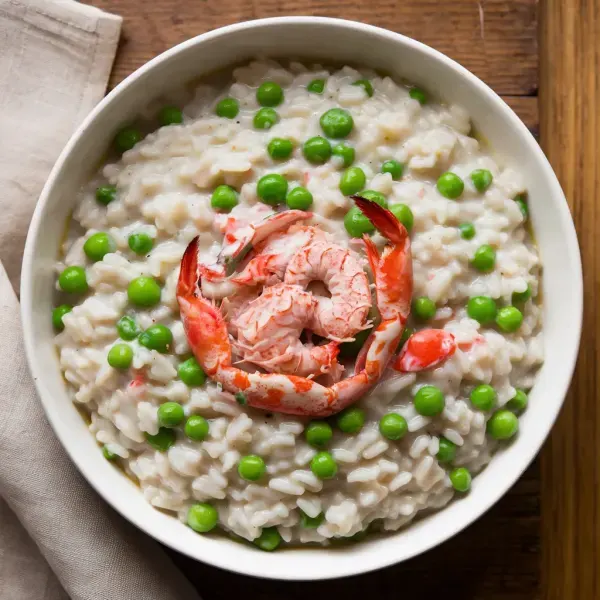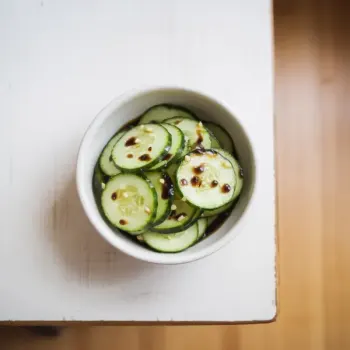
 50 minutes
50 minutesA delightful dish that combines the sweet, delicate taste of crab with the vibrant freshness of peas in a rich, creamy Arborio rice.


quarts
tablespoons
tablespoons
Shallots, small-diced
cups
Fennel, chopped and cored
cups
Poblano Pepper, seeded and small-diced
cups
Garlic, minced
teaspoons
teaspoons
Saffron Threads
teaspoons
teaspoons
Arborio Rice
cups
cups
Creme fraiche
cups
to taste
to taste
Frozen Peas, defrosted
cups
Chives, minced
for serving
Lemon Zest, freshly grated
for serving
1. Simmer Seafood Stock
Start by bringing the seafood stock to a gentle simmer in a medium saucepan. Keep it warm throughout the cooking process, as this will help the rice absorb the liquid evenly, resulting in a creamy texture.
2. Sauté Vegetables
In a medium pot or Dutch oven, heat the butter and olive oil over medium heat until the butter melts. Add the shallots, fennel, and poblano pepper, and cook them for about 5 minutes, stirring occasionally until they are softened and fragrant.
3. Add Aromatics
Stir in the garlic, fresh thyme leaves, saffron threads, and crushed red pepper flakes. Let these aromatics mingle with the vegetables for about 2 minutes, enhancing the depth of flavor.
4. Coat Rice
Add the Arborio rice to the pot, stirring to coat each grain in the buttery mixture. This step is crucial as it helps the rice absorb flavors and achieve the desired creamy texture.
5. Deglaze with Wine
Pour in the white wine and let it deglaze the pot, scraping up any flavorful bits from the bottom. Stir constantly over medium-low heat until most of the liquid is absorbed, about 5 minutes. This deglazing not only lifts the flavors but also adds a bright acidity to balance the creamy richness.
6. Add Stock Gradually
Gradually add the simmering seafood stock to the rice, one ladle at a time. Stir frequently and allow the rice to absorb most of the liquid before adding the next ladle. This gradual cooking over 25 to 30 minutes is key to achieving the perfect al dente texture and creamy consistency.
7. Stir in Crème Fraîche
Once the rice is cooked, stir in the crème fraîche and season with salt and freshly ground black pepper to taste. The crème fraîche will add a luxurious creaminess that ties the dish together.
8. Add Crab and Peas
Gently fold in the fresh crabmeat and defrosted peas, allowing them to warm through for about 2 minutes. If the risotto feels too thick, adjust the consistency with a splash of the simmering stock.
9. Serve
Serve the risotto immediately in large, shallow bowls. Garnish with a sprinkle of minced chives and a touch of freshly grated lemon zest for a refreshing finish.
Arborio, Carnaroli, or Vialone Nano rice are the best varieties for risotto because of their high starch content, which gives risotto its characteristic creaminess. Carnaroli is often preferred by chefs for its ability to stay firm longer and achieve a perfect al dente texture.
The rice should be al dente with a slight bite to it. The risotto should be creamy and fluid enough to spread slightly when ladled into a plate.
Add the hot stock one ladle at a time, stirring constantly, allowing each addition to be nearly absorbed before adding the next. Stir gently to prevent breaking the rice grains.
Have all your ingredients measured and ready before you start. Risotto requires constant attention, and having everything at your fingertips is vital. Use homemade seafood or vegetable stock that complements the delicate flavors of crab and peas. Keep it simmering on the stove to ensure it's hot when ladling into the risotto.
Gently fold in fresh crab meat and peas towards the end of the cooking process to avoid overcooking them. This ensures the crab remains succulent, and the peas retain their vibrant color and sweet flavor.




Comments (0)